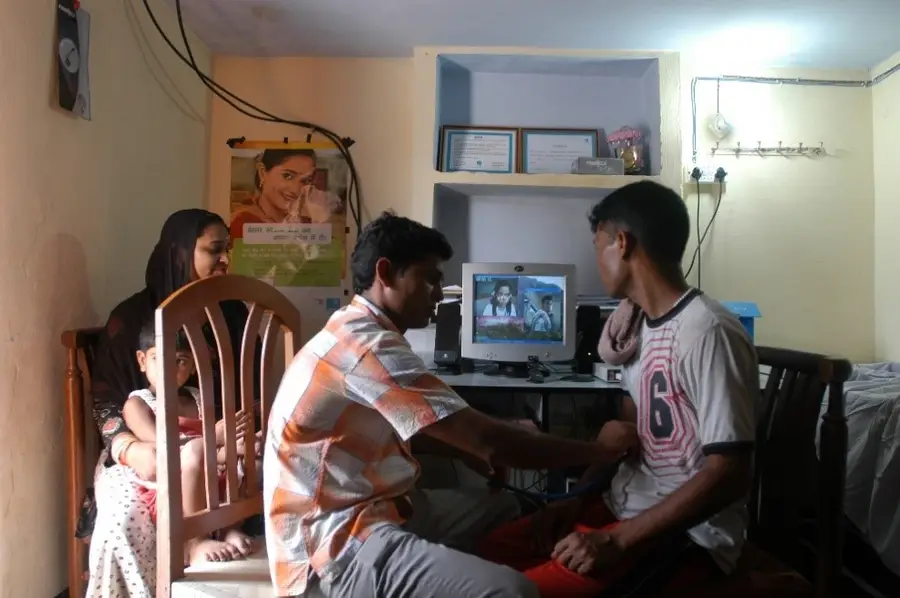
A rural family in Uttar Pradesh, India, uses at-home telemonitoring technology for a virtual consultation. Photo by WorldHealthPartners, licensed under CC 4.0
As global populations are affected by barriers to access to care, the continual expansion of telehealth is changing the way we approach health care, and improving patient access and outcomes. Read on to learn more about the benefits of telehealth, what to expect moving forward, and how RTI is helping to improve telehealth access for the world’s most at-risk populations.
How Telehealth Navigates Immobility & Isolation
The California Valley Fire in 2015 was the fifth most destructive wildfire in California’s history; it took over a month to contain and destroyed nearly two thousand buildings, leaving many Californians stranded. It wasn’t just homes that were devastated, but also healthcare facilities across the state: hospitals, orthopedic centers, and urgent care facilities. Patients with chronic, debilitating conditions were forced into a tough spot, yet despite the chaos, one Californian was still able to receive reliable outpatient care for a spinal cord injury (SCI). The patient faced all the usual critical challenges: scarce medical equipment, barriers to mobility, and loss of nearby medical centers. Except he had one significant advantage: access to telehealth.
What is Telehealth?
Telehealth is a mode of providing health services and information to patients using telecommunication technologies.
How is Telehealth Implemented?
Due to the wide scope of medical care, telehealth has taken on various forms. The COVID pandemic transformed the spatial aspect of everyday services; many of us think of telehealth as virtual consultations through audio and video technologies such as Zoom. However, telehealth is also being implemented through mobile health (mHealth) applications, which patients use to asynchronously contact healthcare providers, track their health records, and access helpful information.
What is Telemonitoring?
A branch of remote health monitoring, called home telemonitoring, utilizes peripheral technologies such as at-home blood pressure machines to track a patient’s health from the convenience of their own home. The case study from the California Valley Fire used both virtual visit consultations through FaceTime as well as home telemonitoring methods for their SCI outpatient care.
Creating a Consolidated Telehealth Platform
Beyond the previously identified telehealth applications, there are other ways telehealth can be integrated into the current healthcare infrastructure to provide more efficient and accessible services. One example is RTI International’s initiative in building a telehealth portal that offers a list of health services on a single, consolidated platform. Lab 58, a corporate innovation lab operating inside RTI, is spearheading the project.
By combining the knowledge of medical experts, software engineers, and other architects, Lab 58 aims to create a telehealth interface that caters to the needs of both patients and practitioners. Potential patient-facing functions include a patient profile, in-app video and audio calling, and e-prescription services. Potential practitioner-facing functions include a practitioner profile, a database for storing electronic health records, and test results management. Most importantly, Lab 58’s portal will follow all guidelines to ensure telehealth accountability of physicians and patients. Broadband, or internet connectivity, is a basic component for the telehealth portal, but according to the Federal Communications Commission (FCC), approximately 19 million Americans, 6 percent of the population, lack access to broadband services at minimum speeds. There has been concern, however, that this could be an underestimate. More accurate data reporting indicates that this number may be closer to 42 million Americans—a startling number of households that could potentially have no access to telehealth. RTI is exploring the possibility of coordinating with internet providers and exploring various avenues to bridge this digital divide.
Telehealth Benefits for Patients and Providers
While telehealth cannot entirely replace in-person medical services, it can be used to enhance the care and treatment that medical facilities and practitioners provide. Remote care eliminates inefficiencies in time, space, and staffing within medical facilities. There is no longer any need for patients to occupy waiting rooms or for staff to check them in. This minimizes costs to both patients and health care providers and allocates this space and time to patients that require more intensive care. In one study, the Duke Clinical Research Institute found that using virtual rehabilitation saved almost $2,750 in costs for physical therapy after total knee replacement surgery. Post-operation follow-up visits, chronic care management, and other outpatient treatments are all prime candidates for telehealth implementation, due to the greater level of independence patients often have in these medical situations.
Telehealth Benefits for Rural Populations
Rural areas may benefit the most from telehealth services. Past research has linked a high prevalence of substance abuse in rural areas to poverty and lack of health care access, but telehealth may be a solution. A-CHESS, Addiction Comprehensive Health Enhancement Support System, is a smartphone app developed by CHESS Health that improved the retention rates of Appalachian women receiving treatment for substance-use disorders (SUDs). Retention in treatment programs is an important factor in SUD relapse prevention. Through its communication features, A-CHESS allows patients to receive sustained emotional support and intervention even after being discharged from in-patient treatment. In rural areas where in-person medical care can be costly or virtually inaccessible, telehealth can make a large impact.
Telehealth and Neglected Tropical Diseases
There has also been emerging research in the use of telehealth for the diagnosis and treatment of neglected tropical diseases (NTDs) and natural disaster preparedness. The latter has been observed through the mobilization of telehealth services during the California Valley Fire, Hurricane Ike in 2008, and the 7.6-magnitude earthquake that hit Pakistan in 2005. In all three cases, telehealth services played a critical role in providing care in the aftermath of these disasters. Telehealth has a unique capability to overcome geographical barriers in medicine. This capability may prove useful for providing diagnoses and treatment for neglected tropical diseases, which disproportionately impact impoverished regions where healthcare access is limited. Telecommunication can connect disease specialists to possibly infected patients, providing specialized consultations with less risk and cost of travel involved. RTI is exploring the use of its telehealth portal project to prevent the spread of neglected tropical diseases such as trachoma and lymphatic filariasis. The technology will be tested first in areas of North and South Carolina where geographic features may form obstacles to healthcare and broadband access, before it can be scaled for use in international settings where NTDs are common.
Areas for Telehealth Improvement and Future Considerations
Implementing telehealth in areas where the technological framework may not be robust enough to support it will be challenging. RTI has coordinated with other organizations currently conducting broadband projects in the Carolinas and has plans to partner with internet providers to try and expand the reaches of high-speed internet in North Carolina and South Carolina, where hospitals in rural areas are being impacted by the digital divide. In 2019, the Federal Communications Commission established the Rural Digital Opportunity Fund (RDOF), a $20.4-billion fund to assist businesses working to expand broadband access in unserved and underserved regions.
The U.S. Department of Agriculture recently awarded $74 million in grants to rural health facilities through the Emergency Rural Health Care Grants Program. This program, launched in August 2021 with funds from the American Rescue Plan Act, will provide support for rural health care providers implementing telehealth and other improvements following the pandemic. RTI hopes these grants can be leveraged to increase the capabilities of its telehealth project and offer seamless telecommunication services.
As much promise as telehealth holds for reducing healthcare inequities, it will take time and careful planning to integrate it into a highly complex medical system. A concern voiced by stakeholders is how telehealth will fit into the Medicare system and medical licensing policy. There has been some progress in these areas after the COVID-19 pandemic spurred greater consideration for digital health opportunities. Federal COVID-19 waivers, which Congress just extended via Fiscal Year 2023 Appropriations, make it easier for health care providers to deliver telehealth services to Medicare and Medicaid patients, including audio-only services, which may open doors for telehealth in the future. An expansion of these waivers could allow more people to receive the benefits of telehealth. With the pandemic in the forefront of our minds, and a laundry list of diseases left untreated in many parts of the world, RTI’s investment in accountable telehealth infrastructure will be a powerful tool for improving the human condition.

